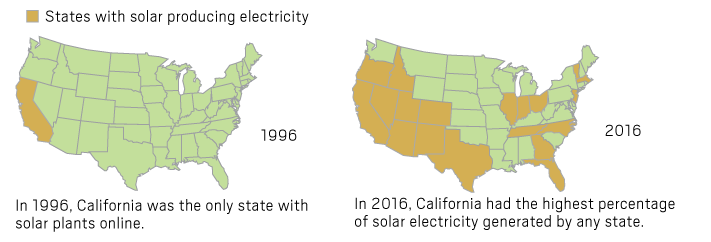
This week, Gov. Jerry Brown joined several other governors at the U.S. Climate Alliance in New York, saying: “We’re all in and we’ll keep going and eventually Washington will join with us because you can’t deny science forever. You can’t deny reality. And that reality is climate change is occurring.”
Last week, California’s Senate Bill 100 didn’t make it to the governor’s desk but those who support making California carbon neutral by 2045 aren’t giving up. The bill would have accelerated the state’s existing goals to decarbonize the state’s power grid, with the requirement that California reach 100 percent renewable energy by 2045.
It’s an ambitious goal.
As of 2015, about 28 percent of energy from the state’s three largest utility companies came from renewable sources, according to the California Public Utility Commission. Ambition might outpace existing technology because it would require breakthroughs in energy storage to meet the goal.
Southern California Edison opposed the bill, arguing customers could be burdened with high costs.

The bill’s proponents disagreed, saying the new milestones are within reach and affordable, and the legislation itself serves as a driver of innovation in the clean energy sector.
“I think it’s really obtainable,” said Kevin de Leon, D-Los Angeles, the California senate president pro tem who introduced the bill. “Three decades into the future gives us plenty of time to really figure this out.” Legislative efforts such as SB 100, “send a clear message to Washington that with or without them we’re going to move forward with clean energy because it’s the right thing to do and it can be done.”
SB 100 may have been derailed but several bills regarding California’s air quality sailed through. Two bills, AB 109 and AB 134, are on the governor’s desk and they have ambitious standards of using the state’s cap and trade money to replace diesel engines in heavy trucks and buses to make them electric vehicles.
PIE IN THE CLEAN SKY?
A look at how a carbon-neutral state might look:

JOBS
California already has the most solar jobs and industry experts said the state could continue to outpace the rest of the U.S.
According to the most recent California Green Innovation Index, job growth outpaced the rest of the country by 27 percent after the state passed its landmark Global Warming Solutions Act in 2006. The index also found that in California for every fossil fuel job, there are 8.5 in renewable energy.
HOME IS WHERE THE HYDROGEN IS
UC Irvine researcher Jack Brouwer, a professor of mechanical engineering, said SB 100 didn’t go far enough.
Under a bill focused on decarbonizing the electric grid, homes could move more toward electrifying appliances which could be a lifestyle shift for some Californians, Brouwer said. One area of research he focuses on is the power-to-gas model, which uses solar energy and pure water to store energy as hydrogen for longer periods of time.

“There are some scenarios in which the homes are going to electrify everything, and if they electrify everything in those homes you won’t have the gas grill, you won’t have the gas cook top, you won’t have the cheaper gas dryer, and most importantly you won’t have gas heating. And that’s going to feel very different,” said Brouwer, who is also the associate director of the National Fuel Cell Research Center.
Brouwer believes Californians would be better served by decarbonizing both the electric grid and natural gas. In that scenario, the state could begin replacing natural gas with hydrogen with minimal changes to the existing infrastructure. If the state were to move to hydrogen, it would encourage long haul trucks to move to fuel cells among other changes.
THE LANDSCAPE

Wind turbines, like those found on the San Gorgonio Pass, and solar farms will likely be increasingly common. Rooftop solar installations in suburban settings will also increase, but be outpaced by large operations in open spaces in the state’s deserts and mountain regions.
WHERE WE ARE TODAY
Progress with renewable energy

Total generation of in-state electricity by fuel type in megawatts.

LEADING THE WAY
California lead the way in active solar plants and wind-power plants.

Sources: California Solar Statics, Center for Sustainable Energy, Southern California Edison, U.S. Energy Information Administration, Electric Power Monthly, California Senate




